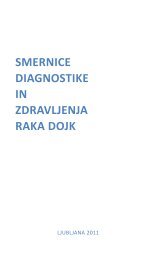You also want an ePaper? Increase the reach of your titles
YUMPU automatically turns print PDFs into web optimized ePapers that Google loves.
Cathepsins and their inhibitors in head and neck cancer<br />
Primo` Strojan<br />
Department of Radiation Oncology, Institute of Oncology, Zalo{ka 2, SI-1000 Ljubljana,<br />
Slovenia (pstrojan@onko-i.si)<br />
Head and neck cancer comprises approximately 5% of newly diagnosed invasive<br />
malignancies. More than 95 % of tumors are of epithelial origins: histologically<br />
they belong to the group of squamous cell carcinomas. Alcohol and tobacco abuse<br />
are common etiologic factors for oral cavity, oropharyngeal, hypopharyngeal,<br />
and laryngeal cancers. Moreover, because the entire aerodigestive epithelium<br />
may be exposed to these carcinogens, patients with head and neck cancer are at<br />
risk for developing second primary neoplasms of the head and neck, lung, and<br />
esophagus.<br />
Successful treatment of head and neck cancer requires accurate risk stratification to<br />
determine the type and extent of therapy needed and the expected clinical outcome.<br />
Physical examination, diagnostic imaging studies, and pathologic review are aimed<br />
to determine the size and extent of the primary tumor (T-stage), the status of regional<br />
(cervical) lymph nodes (N-stage), and the likelihood of systemic metastases (Mstage).<br />
In addition to TNM staging, other clinical and pathological factors have been<br />
shown to influence response to therapy and outcome.<br />
Cathepsins are a group of lysosomal cysteine (cathepsins B, H, L and others) or<br />
aspartic proteases (cathepsin D) that are involved predominantly in phagolysosomal<br />
protein degradation. Most of the cathepsins are expressed ubiquitously, but a few<br />
demonstrate strict tissue specificity. Endogenous inhibitors of cysteine cathepsins<br />
belong to cystatins, which are subdivided into three families, i.e. stefins, cystatins,<br />
and kininogens, and thyropins, whereas the naturally occurring inhibitor of aspartic<br />
protease, cathepsin D, has not been found yet in men.<br />
l15<br />
29<br />
During the last decades it has been shown that pericellular proteolysis has multiple<br />
roles in virtually all aspects of the normal life of a cell, such as protein degradation,<br />
antigen presentation, bone resorption and hormone processing. The same process<br />
is involved in the degradation of extracellular matrix barriers during invasion and<br />
metastasizing.<br />
The predictive and prognostic value of individual cathepsins and their inhibitors<br />
was widely investigated in breast, lung, and colorectal carcinoma. Compared to<br />
these tumors, the squamous cell carcinoma of the head and neck fall into much less<br />
investigated group of cancers. Apart from the studies focused to the activity or level<br />
of cathepsins and their inhibitors as determined in matched pairs of tumor tissue<br />
and normal mucosa, there are only a limited number of reports in the literature<br />
assessing their predictive or prognostic value in this H&N cancer. There are several<br />
reasons, the two most important being:<br />
• head and neck cancers appear to be a heterogeneous group of tumors<br />
consisting of multiple primary sites inside the upper aerodigestive tract,<br />
each with its own natural history and treatment outcome

















